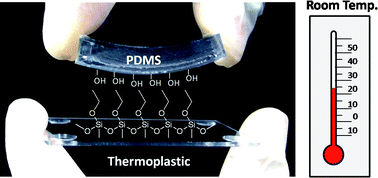We describe a simple and versatile method for bonding thermoplastics to elastomeric polydimethylsiloxane (PDMS) at room temperature. The bonding of various thermoplastics including polycarbonate (PC), cyclic olefin copolymer (COC), polymethylmethacrylate (PMMA), and polystyrene (PS), to PDMS has been demonstrated at room temperature. An irreversible bonding was formed instantaneously when the thermoplastics, activated by oxygen plasma followed by aminopropyltriethoxysilane modification, were brought into contact with the plasma treated PDMS. The surface modified thermoplastics were characterized by water contact angle measurements and X-ray photoelectron spectroscopy. The tensile strength of the bonded hybrid devices fabricated with PC, COC, PMMA, and PS was found to be 430, 432, 385, and 388 kPa, respectively. The assembled devices showed high burst resistance at a maximum channel pressure achievable by an in-house built syringe pump, 528 kPa. Furthermore, they displayed very high hydrolytic stability; no significant change was observed even after the storage in water at 37 °C over a period of three weeks. In addition, this thermoplastic-to-PDMS bonding technique has been successfully employed to fabricate a relatively large sized device. For example, a lab-on-a-disc with a diameter of 12 cm showed no leakage when it spins for centrifugal fluidic pumping at a very high rotating speed of 6000 rpm.


 Please wait while we load your content...
Please wait while we load your content...